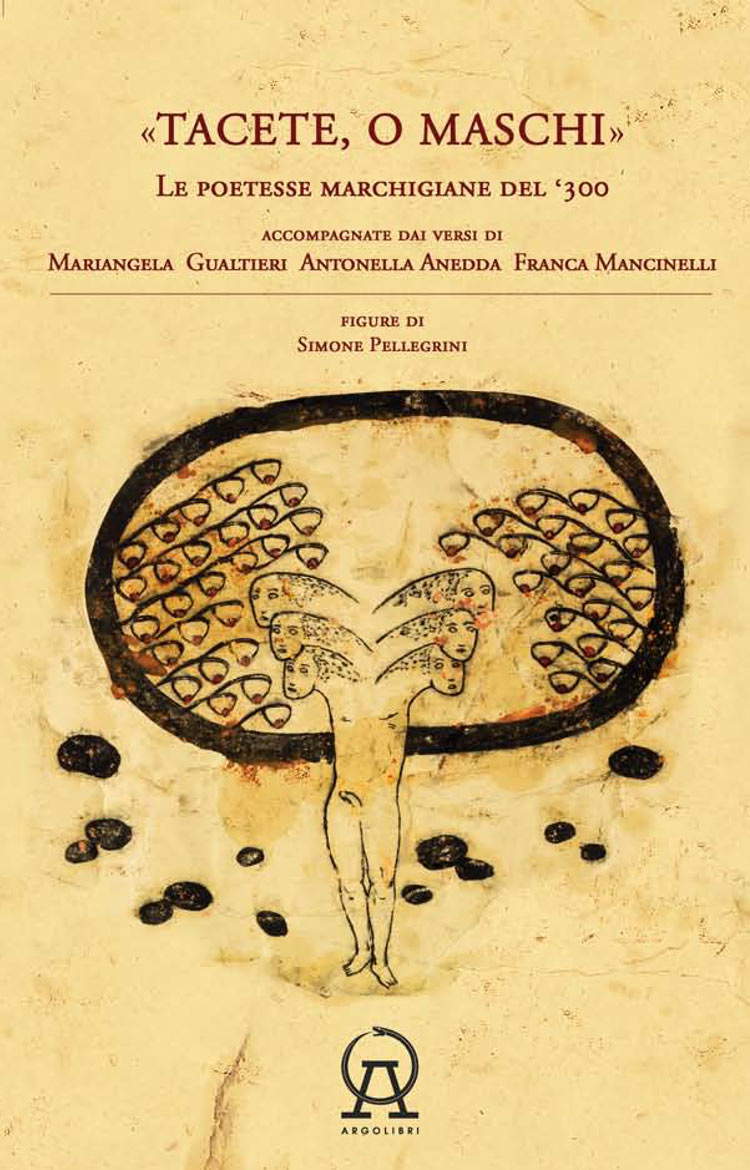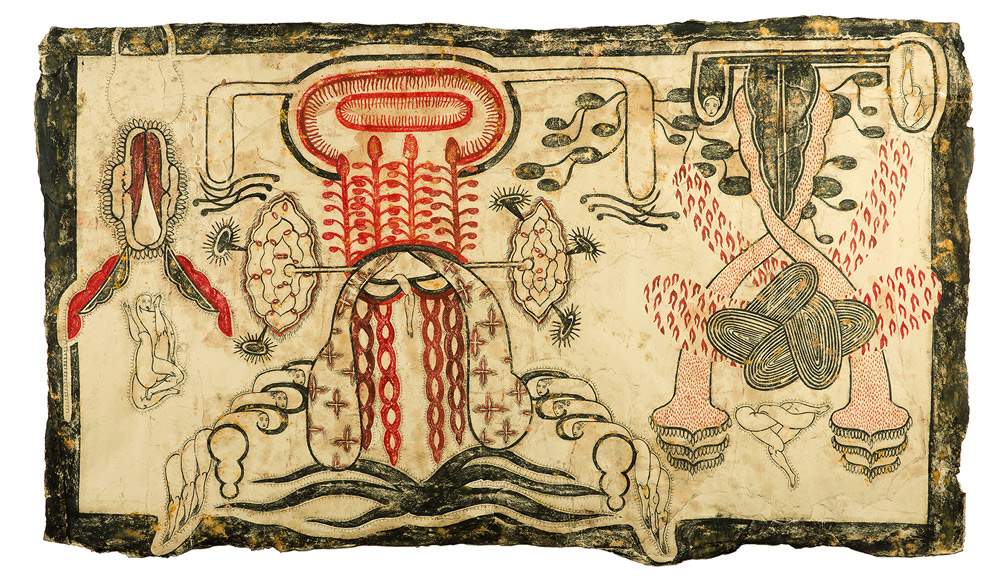A book that combines literature and art: the publishing house Argolibri publishes Tacete o maschi. Le poetesse marchigiane del Trecento (64 pages, €18.00, ISBN 9788831225045), edited by Andrea Franzoni and Fabio Orecchini, with images by Simone Pellegrini. The volume composes an anthology of four poetesses active in the Marche region in the 14th century, namely Leonora della Genga, Ortensia di Guglielmo, Livia da Chiavello and Elisabetta Trebbiani, whose lyrics are accompanied by the verses of three contemporary poets (Mariangela Gualtieri, Antonella Anedda and Franca Mancinelli) and, indeed, by Pellegrini’s works on paper.
For many, this will be a real discovery: the figures of the four women poets are in fact little known but, Mercedes Arriaga Flórez and Daniele Cerrato write in the introductory essay, they represent the “first generation of women writers in Italian literature,” the first, therefore, to constitute a unified group (they are not, however, the first in absolute terms, since we know of some female exponents of the Sicilian school who lived before the poets of Marche). Women well inserted in the cultural circles of their time (Hortensia di Guglielmo is also credited with a sonnet addressed to Francesco Petrarch: A sonnet by the great poet from Arezzo is also known and is considered by some scholars to be a response to her colleague), women who with their verses sanction, Arriaga Flórez and Cerrato write again, “the affirmation of a female self in matters of love (which refuses to be a mere object of male desire in order to propose itself as a subject with decision-making capacity) and the protest against family impositions in matters of marriage,” women who are well aware of the power of their art and consider themselves equal to men in an activity, that of poetry, which in ancient times was considered the prerogative of the male sex.
 |
| The cover of Quiet O Males. Women poets of the Marches in the fourteenth century. |
A sonnet by Leonora della Genga is particularly revealing of the ambitions of female poets to be treated as equals to men (this is the poem that gives the book its title): “Tacete, o maschi, a dir, che la Natura / a far il maschio solamente intenda, / e per formare la femmina non prenda, / se non contra sua voglia alcuna cura. [...] / They know how women handle swords, / They know how to rule Empires, and they still know / To find the straight path in Helicon. / In all things your valor falls, / Men, after them. Man never forsakes / to torne of valor, or crown.” However, the prejudice against women devoted to poetry would be destined to last until the twentieth century, and even today imbalances remain in the spaces allocated to women in literature, partly because over the centuries criticism has not benefited women’s poetry, which continued well beyond the experience of the fourteenth-century female poets of Marche (think of great Renaissance figures such as Gaspara Stampa, Laura Battiferri and Vittoria Colonna, for example): in the nineteenth century, for example, the verses of the Marches poetesses were known, but they were thought to be forgeries (Giosuè Carducci, for example, was convinced of this, according to whom they were lyrics invented out of whole cloth by Andrea Gilio and Egidio Menagio). Today, however, we know that Leonora della Genga, Ortensia di Guglielmo and their colleagues really existed: documents have been found, there are mentions in contemporary chronicles, which have enabled contemporary research to affirm with conviction the real existence of the poetesses from the Marche.
The book published by Argolibri therefore brings the public to the knowledge of this little-known panorama: the women poets of the Marches in the fourteenth century, Arriaga Flórez and Cerrato write again, “thus come to constitute the missing piece to complete the literary picture of this century, revealing female dissidence not already as a marginal phenomenon (if only in certain social classes such as the bourgeoisie and the nobility) but as a reality already then endowed with its own literary expression, in verse and prose, in both the religious and secular spheres.” We then know that the poetesses were also in dialogue with each other: a fine plazer by Leonora della Genga addresses Hortensia di Guglielmo, dedicating high praise to her poetry (“Let Thessaly Apollo, Anfriso, and Delos; / and here you bring the lyre, and here the herds / graze, and here you plant the evergreen laurels. / These the triumphs be, these the honors / of you Hortense, to whose gentle accents / the world is made quiet, and the heavens open.”). There are various themes, from the desire to affirm gender equality (read the wonderful sonnet “Io vorrei pur drizzar queste mie piume,” attributed to Hortense, in which the poet expresses her desire to devote herself to poetry, but is forced to face the prejudice of the vulgar: “all’ago, al fuso, più che al lauro o al mirto, / come che qui non sia la gloria mia, / vuol ch’abbia sempre questa mente intesa”) to love, from religious poetry to that which observes with bitterness contemporary events (Livia da Chiavello: “Veggio di sangue uman tutte le strade / d’Italia piene, il qual per tutto corre: / e disdegnoso e reo Marte discorre / lance porgendo ognor, saette, e spade”).
As anticipated, Silence O Males. Le poetesse marchigiane del Trecento is completed with the verses of Mariangela Gualtieri, Antonella Anedda and Franca Mancinelli, who, according to ancient usage, respond to the poetesses of the fourteenth century with their lyrics, and with the figure-based journey of an important Marche artist of today, Simone Pellegrini, who with his works on paper, with his maps of symbols, his ancestral visions that create bridges between past and future, projects the poems of the 14th-century poetesses into a timeless space. The genres tackled by Leonora della Genga, Ortensia di Guglielmo, Livia da Chiavello and Elisabetta Trebbiani, write curators Franzoni and Orecchini, in Pellegrini’s works “transgress forms, we could say degenerate, extending the dialogue to the sphere of vision. Pellegrini’s figurative apparatus sits precisely in this temporal boundary left open by the word, at the same time archetypal and futuristic, in which everything is continually transformed and translated, infecting itself with the organic, the vegetable and the biological, just as poetry has always done.”
 |
| Simone Pellegrini, Diaphanous Vario (2017; mixed media on paper, 95 x 165 cm) |
 |
| Be silent, O males: a book recovers the verses of fourteenth-century Marche poetesses |
Warning: the translation into English of the original Italian article was created using automatic tools. We undertake to review all articles, but we do not guarantee the total absence of inaccuracies in the translation due to the program. You can find the original by clicking on the ITA button. If you find any mistake,please contact us.